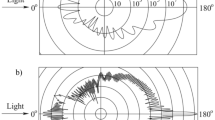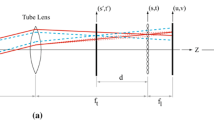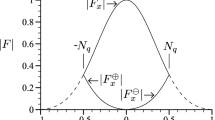Abstract
Recently, a number of techniques have been presented for the determination of the third “out-of-plane” velocity component in micro particle image velocimetry (micro-PIV) data. In particular, the conventional macroscopic stereo-PIV technique has been converted to the micro scale by the use of stereo-microscopy. In this work a different technique is investigated, which uses conventional, two-component micro-PIV to generate velocity data on a number of planes. The in-plane velocity gradients are then calculated, which can be used in the continuity equation to produce the out-of-plane velocity gradients. These, together with the no-penetration boundary condition, can then be used to calculate the out-of-plane velocities. An algorithm is presented that is capable of handling up to one invalid vector per column of data by using a combination of first order and second order projections of the velocity. The advantage of the continuity based technique is that it uses the existing two-component micro-PIV technology, which at present is in a more advanced stage of development then stereo-microscopy based micro-PIV. The technique is investigated using a flow similar to one used previously to assess stereoscopic micro-PIV (Meas Sci Technol 17:2175–2185, 2006). This allows a comparison of the performance of the two techniques. The results show that the continuity based data agrees well with an independent computational fluid dynamics solution and has a smaller experimental uncertainty than the stereoscopic technique at a better spatial resolution. There are, however, potential limitations to the continuity based technique. These include the two-dimensionality of the data, which is limited to the planes on which the original images were taken, and the dependence of the technique on the data close to surfaces, where the experimental errors are often greatest. Stereoscopic micro-PIV does not have these limitations so, whilst at present it appears that continuity based techniques may be more accurate, there is sufficient potential for stereoscopic techniques to justify their further development.






Similar content being viewed by others
References
Bown MR, MacInnes JM, Allen RWK (2005) Micro-PIV measurement and simulation in complex microchannel geometries. Meas Sci Technol 16:619–626
Bown MR, MacInnes JM, Allen RWK, Zimmerman WBJ (2006) Three-dimensional, three-component velocity measurements using stereoscopic micro-PIV and PTV. Meas Sci Technol 17:2175–2185
Delnoij E,Westerweel J, Deen NG, Kuipers JAM, Van Swaaij WPM (1999) Ensemble correlation PIV applied to bubble plumes rising in a bubble column. Chem Eng Sci 54:5159–5171
Klank H, Goranovic G, Kutter JP, Gjelstrup H, Michelsen J (2002) PIV measurements in a microfluidic 3d-sheathing structure with three dimensional flow behaviour. J Micromech Microeng 12:863–869
Lindken R, Westerweel J, Wieneke B (2006) Stereoscopic micro particle image velocimetry using self-calibration on particle images. Exp Fluids 41:161–171
Meinhart CD, Wereley ST, Santiago JG (1999) PIV measurements of a microchannel flow. Exp Fluids 27:414–419
Meinhart CD, Wereley ST, Santiago JG (2000) A PIV algorithm for estimating time averaged velocity fields. J Fluids Eng 122:285–289
Olsen MG, Adrian RJ (2000) Out-of-focus effects on particle image visibility and correlation in microscopic particle image velocimetry. Exp Fluids S166–S174
Park JS, Choi CK, Kihm KD (2004) Nanoparticle tracking using CLSM(confocal laser scanning microscopy) and OSSM (optical serial sectioning microscopy) imaging. J Heat Transf 126:504
Robinson O, Rockwell D (1993) Construction of three-dimensional images of flow structure via particle tracking techniques. Exp Fluids 14:257–270
Rohaly J, Lammerding J, Frigerio F, Hart DP (2001) Monocular 3-D active micro-PTV. In: Proceeding of the 4th international symposium on particle image velocimetry, Gottingen, Germany, 17–19 September, pp 1–4
Santiago JG, Wereley ST, Meinhart CD, Beebe DJ, Adrian RJ (1998) A particle image velocimetry system for microfluidics. Exp Fluids 25:316–319
Vennemann P, Kiger KT, Ursem NTC, ten Hagen TLM, Stekelenburg-de Vos S, Groenendijk BCW, Lindken R, Poelmann RE, Westerweel J, Hierck BP (2005) In vivo micro PIV in the embryonic avian heart. Proc. 6th International Symposium on Particle Image Velocimetry PIV’05, Pasadena, California, USA, September 21–23, S11-4:P088
Wereley ST, Meinhart CD (2001) Second order accurate particle image velocimetry. Exp Fluids 31:258–268
Wu Z, Truong T-Q, Nguyen N-T, Huang X-Y (2003) Characterisation of microfluidic devices using micro particle image velocimetry. Int J Comp Eng Sci 4:269–272
Author information
Authors and Affiliations
Corresponding author
Rights and permissions
About this article
Cite this article
Bown, M.R., MacInnes, J.M. & Allen, R.W.K. Three-component micro-PIV using the continuity equation and a comparison of the performance with that of stereoscopic measurements. Exp Fluids 42, 197–205 (2007). https://doi.org/10.1007/s00348-006-0229-3
Received:
Revised:
Accepted:
Published:
Issue Date:
DOI: https://doi.org/10.1007/s00348-006-0229-3




